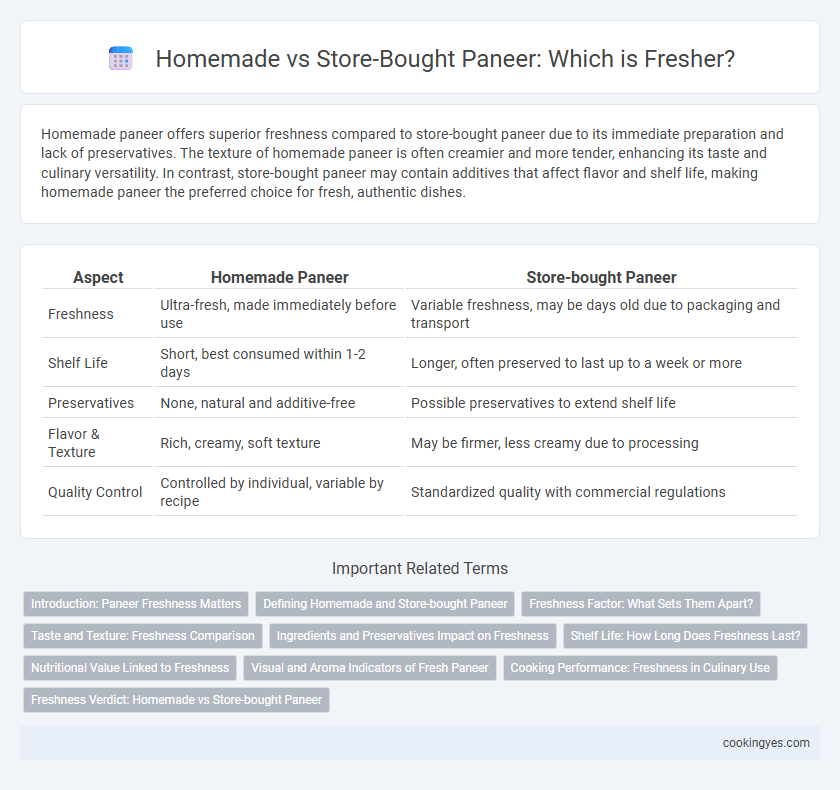Homemade paneer offers superior freshness compared to store-bought paneer due to its immediate preparation and lack of preservatives. The texture of homemade paneer is often creamier and more tender, enhancing its taste and culinary versatility. In contrast, store-bought paneer may contain additives that affect flavor and shelf life, making homemade paneer the preferred choice for fresh, authentic dishes.
Table of Comparison
| Aspect | Homemade Paneer | Store-bought Paneer |
|---|---|---|
| Freshness | Ultra-fresh, made immediately before use | Variable freshness, may be days old due to packaging and transport |
| Shelf Life | Short, best consumed within 1-2 days | Longer, often preserved to last up to a week or more |
| Preservatives | None, natural and additive-free | Possible preservatives to extend shelf life |
| Flavor & Texture | Rich, creamy, soft texture | May be firmer, less creamy due to processing |
| Quality Control | Controlled by individual, variable by recipe | Standardized quality with commercial regulations |
Introduction: Paneer Freshness Matters
Homemade paneer offers superior freshness compared to store-bought varieties, as it is prepared using fresh milk without preservatives, ensuring a creamy texture and rich flavor. Store-bought paneer often contains additives and is exposed to longer storage times, which can affect its softness and taste. Freshness directly impacts the quality of paneer in dishes like paneer tikka and palak paneer, making homemade paneer a preferred choice for authentic flavor and texture.
Defining Homemade and Store-bought Paneer
Homemade paneer is freshly crafted by curdling milk with natural acids like lemon juice or vinegar, ensuring superior freshness and customizable texture. Store-bought paneer is mass-produced, often containing preservatives to extend shelf life, which may affect its natural flavor and softness. Prioritizing homemade paneer guarantees chemical-free, nutrient-rich freshness compared to commercially available options.
Freshness Factor: What Sets Them Apart?
Homemade paneer offers superior freshness due to its immediate preparation and absence of preservatives, ensuring a soft texture and rich, milky flavor. Store-bought paneer undergoes packaging and refrigeration processes that may slightly diminish its freshness and result in a firmer texture. The freshness factor significantly affects taste and mouthfeel, making homemade paneer preferable for dishes requiring delicate curd consistency.
Taste and Texture: Freshness Comparison
Homemade paneer offers superior freshness with a soft, crumbly texture and rich, milky flavor that store-bought varieties often lack due to preservatives and prolonged storage. Store-bought paneer can be denser and less flavorful, as commercial processing tends to reduce its natural creaminess and tenderness. Choosing homemade paneer ensures optimal taste and texture, enhancing dishes with its authentic freshness.
Ingredients and Preservatives Impact on Freshness
Homemade paneer uses fresh milk and natural acidifying agents like lemon juice or vinegar, resulting in higher freshness and a cleaner taste compared to store-bought paneer, which often contains preservatives to extend shelf life. These preservatives can affect the texture and flavor, making store-bought paneer less fresh and sometimes firmer or rubbery due to additives. Prioritizing homemade paneer ensures no artificial chemicals interfere with its natural aroma and softness, enhancing both quality and nutritional benefits.
Shelf Life: How Long Does Freshness Last?
Homemade paneer retains its freshness for about 2 to 3 days when stored properly in the refrigerator, offering a creamier texture and fresher taste compared to store-bought varieties. Store-bought paneer typically contains preservatives that can extend shelf life up to one week, but may compromise flavor and texture. Freshness duration depends heavily on storage methods, with airtight containers and refrigeration being essential for maintaining optimal quality.
Nutritional Value Linked to Freshness
Fresh homemade paneer retains higher levels of essential nutrients such as calcium, protein, and vitamins compared to store-bought paneer, which may lose nutritional value due to preservatives and longer shelf life. The freshness of homemade paneer ensures better bioavailability of nutrients, supporting optimal digestion and absorption. Choosing homemade paneer can significantly enhance dietary benefits by providing a richer source of vital nutrients directly linked to its freshness.
Visual and Aroma Indicators of Fresh Paneer
Fresh homemade paneer typically exhibits a bright white color with a smooth, crumbly texture, whereas store-bought paneer may appear slightly yellowish or denser due to preservatives. The aroma of homemade paneer is subtly milky and fresh, signaling minimal processing, in contrast to store-bought varieties which sometimes carry a faint sour or chemical scent. Visual indicators like uniformity in block shape and the absence of excessive moisture also suggest higher freshness in homemade paneer.
Cooking Performance: Freshness in Culinary Use
Homemade paneer offers superior freshness, resulting in a softer texture and better moisture retention, which enhances its ability to absorb spices and flavors during cooking. Store-bought paneer often contains preservatives that can slightly alter its taste and firmness, leading to a drier, less creamy consistency in dishes. Freshness in homemade paneer directly impacts cooking performance, delivering richer texture and more vibrant flavor in recipes like paneer tikka or palak paneer.
Freshness Verdict: Homemade vs Store-bought Paneer
Homemade paneer typically offers superior freshness, made from fresh milk without preservatives, preserving its creamy texture and natural flavor. Store-bought paneer may contain additives to extend shelf life, which can slightly affect its taste and freshness. For optimal freshness and rich taste, homemade paneer is generally preferred over store-bought options.
Homemade Paneer vs Store-bought Paneer for freshness Infographic

 cookingyes.com
cookingyes.com